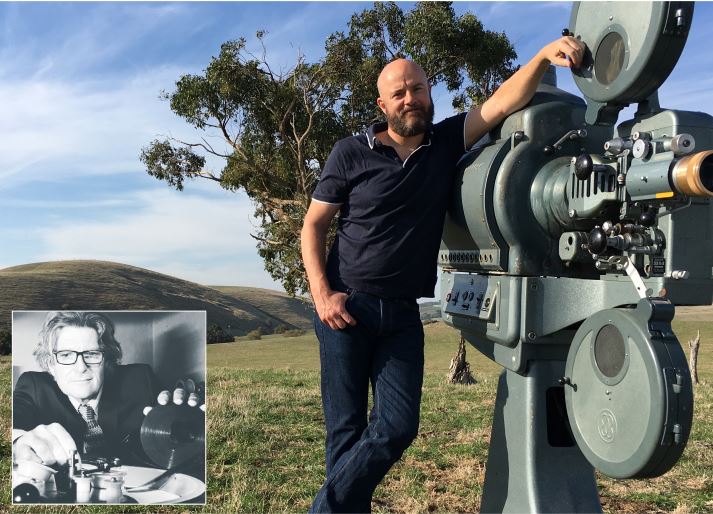February 1st, 2023The doco history of the projectionists’ craft
Words: Tony Sawrey | Main image: Contributed | Inset: Kyle Barnes
A DECADE ago, cinema complexes across Australia were going digital, dumping
their old analog equipment and almost overnight, projectionists found themselves out of a job.
Gone were the old large film reels as movie releases moved to what were known as Digital Cinema Packages.

One of those projectionists was Ken Parfrey, pictured inset, of the Radio Springs Hotel in Lyonville. He began his career at the Carlton Movie House and subsequently worked at numerous theatres around Melbourne and the Melbourne Film Festival before taking over the hotel in 1997.
Cinema Nova
Later Ken heard that Cinema Nova, where he worked for many years, was getting rid of their projectors. “The owners told me to come and get them,” Ken recalls, “or they are going to the
tip.”
“We brought them here and decided to do a backyard blitz as it were and do up the garage as a form of cinema/ performance space using the salvaged machines.”
Today, Ken maintains his old role of movie projectionist in one of only a handful of theatres in Victoria that still present celluloid as a relic of a bygone age.
Splice Here
But now, more than a decade after the demise of film in most commercial venues, it is the subject of Splice Here: A Projected Odyssey, a documentary by filmmaker and former projectionist Rob ‘Bert’ Murphy, pictured main image.
Debuting at the 2022 Melbourne International Film Festival and also having been shown at the Wide Screen Weekend in England and DOC NYC in America, the documentary explores the history of the projectionists’ craft over the decades and the enthusiasts who today hoard old film stock, equipment and maintain film-only theatres around the world.
This network of mostly retired projectionists offers a fascinating glimpse into a lost world and Bert points out that; “There are a few key people in the projectionists’ underground and Ken is one of them. He was chief projectionist at Carlton’s Cinema Nova and an important character in Melbourne film culture. That’s why he features prominently in Splice Here.”
The digital age
The digital age as we know it has been around since the early 2000s. In 2023
everything from music to books, news and film via the internet, streaming and
formats such as MP4 are produced and distributed in digital format.
During that time an entire generation of people have grown up knowing nothing
else but digital. However, while there remain people who remember the days when
movies were recorded and exhibited on celluloid ribbon treated with light sensitive
chemicals instead of ones and zeros, there will remain an endless digital vs film debate
sitting at the very heart of the work.
The documentary begins by delving into Cinerama, a format which emerged in
the 1950s presented on enormous, curved screens utilising three separate projectors.
The search
From here Bert explores the world of projected film and goes searching for old
equipment and mouldering prints in museums, sheds and abandoned rural theatres.
He talks to archivists, filmmakers and producers and documents the return of film-
only events including the debut of Quentin Tarantino’s The Hateful Eight on 70mm at
the Sun Theatre in Yarraville in 2016.
One of the things about shooting and projecting digital is it’s a great medium
and has allowed a lot of amazing new things to be done,” says Bert. “It’s just that it
has also introduced a certain form of laziness to the production process and I have
always felt that digital is a poor substitute for the look of film which has both a
softness and richness that’s hard to surpass.”
Re-emergence
Despite a downturn during Covid, there has been a gradual re-emergence of film-
only theatres. The most well-known is arguably Tarantino’s New Beverly Cinema in
Los Angeles. Melbourne has two, the Sun and the Astor and they are just a few of
hundreds that have appeared around the world.
While making celluloid prints for commercial release is a luxury that only big
name directors like Quentin Tarantino or J.J. Abrams can swing, there has been a
significant return to celluloid film as Richard Tuohy of Nanolab, Daylesford can
attest.
“Certainly there has been an analog renaissance,” he says. “We have been running
our business for 16 years and the number of people who shoot on film these days
has definitely increased significantly over the last five or six years. The immediate
fascination with digital has passed and an appreciation of what film was or is in
contrast has definitely remerged.”
Film romance
Like with all forms of superseded technology, there is a latent romance connected
to projected film. Its shadow is long and Splice Here, which has a few more theatre
runs before going to DVD and then possibly being streamed, is a love letter to its
memory.
While digital is ubiquitous and here to stay, history has shown that most
communication disruptions from the printing press to social media eventually see old
tech settle back into the cultural fabric in often unexpected ways – due in no small
part to the efforts of people like Bert Murphy and Ken Parfrey making the effort to
rescue old formats from oblivion.
Ken, who hopes to show the documentary at the Radio Springs Hotel, ironically
when he gets a digital projector, says film and old projectors are like “big boys’ toys”.
And there are certainly a network of enthusiasts like himself around the world
who are, as he says, “keeping the dream alive”.










